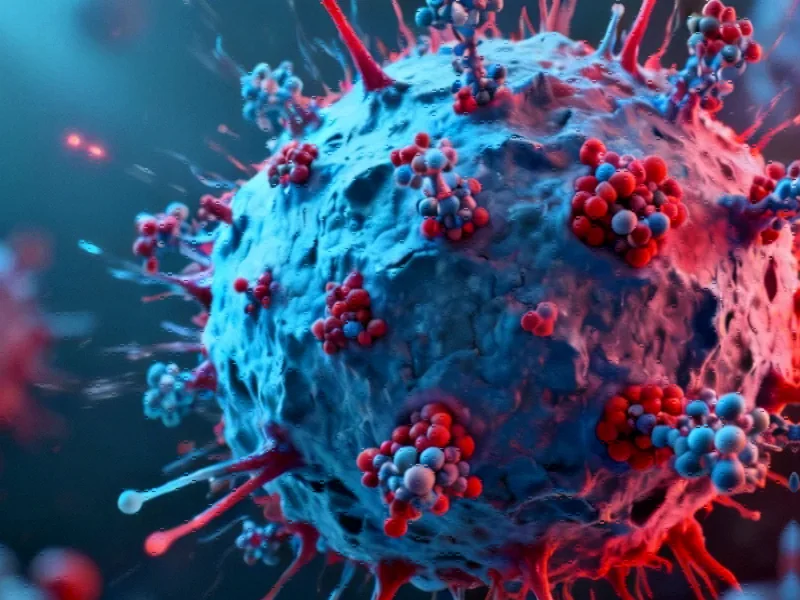Decoding Cancer’s Shape-Shifting Abilities Through Chromatin Architecture
Groundbreaking research published in Nature Communications has revealed a previously unknown mechanism behind cancer’s notorious ability to adapt, evolve, and resist treatment. Scientists have identified TLK2 as a key regulator of chromatin looping that controls cancer stemness plasticity—the dangerous capacity of cancer cells to transform between different states, driving tumor progression and therapy resistance.
Table of Contents
- Decoding Cancer’s Shape-Shifting Abilities Through Chromatin Architecture
- The Chromatin Looping-Cancer Connection
- Experimental Insights and Methodological Innovations
- Cancer Stem Cells: The Architects of Treatment Resistance
- Therapeutic Implications and Future Directions
- Broader Impact on Cancer Research and Treatment
This discovery represents a paradigm shift in our understanding of cancer biology, moving beyond genetic mutations to explore how the three-dimensional organization of DNA within cells contributes to tumor evolution. The implications for cancer treatment are profound, suggesting new avenues for targeting the very architecture that enables cancer’s resilience., according to industry news
The Chromatin Looping-Cancer Connection
Chromatin looping refers to the intricate three-dimensional folding of DNA that brings distant genetic elements into close proximity, enabling precise control of gene expression. Think of it as the organizational system that determines which genes are “accessible” and active at any given time. When this system goes awry, normal cellular programming can be hijacked to support cancerous behavior., according to additional coverage
The research team employed an innovative chromatin looping-based CRISPR screen to systematically identify genes involved in this process. Among thousands of candidates, TLK2 emerged as a central player in regulating the formation of CTCF-cohesin hubs—protein complexes that act as architectural organizers of chromatin loops.
As one researcher explained, “We’ve discovered that TLK2 functions as a master regulator of the chromatin architecture that maintains cancer stem cell properties. When we manipulate TLK2 activity, we can essentially reprogram how cancer cells organize their DNA, potentially making them more vulnerable to treatment.”, according to technology trends
Experimental Insights and Methodological Innovations
The comprehensive study employed multiple cutting-edge techniques to validate TLK2’s role:
- Advanced genetic engineering using CRISPR/Cas9 and RNA interference to precisely manipulate TLK2 expression
- Sophisticated imaging technologies including FRET microscopy to visualize protein interactions in real-time
- High-throughput sequencing approaches to map changes in gene expression and chromatin organization
- Functional assays measuring cancer stem cell properties, proliferation, and colony formation
Researchers worked with multiple cancer cell lines, including breast cancer models (MDA-MB-231, MCF-7, T47D, HCC1806) and other systems, ensuring the findings have broad relevance across cancer types. The experimental protocols received full ethical approval, and all cell lines underwent regular mycoplasma testing to maintain research integrity.
Cancer Stem Cells: The Architects of Treatment Resistance
Cancer stem cells (CSCs) represent a particularly dangerous subpopulation within tumors. These cells possess enhanced abilities to self-renew, differentiate into various cell types, and resist conventional therapies. The plasticity—the ability to switch between stem-like and differentiated states—makes CSCs especially challenging to eradicate.
The study demonstrates that TLK2-mediated chromatin looping directly influences this plasticity. When researchers manipulated TLK2 activity, they observed significant changes in:
- Mammosphere formation capacity—a key indicator of cancer stemness
- ALDH enzymatic activity—a marker of stem-like properties
- Colony formation and proliferation rates
- Cell cycle progression and survival
These findings position TLK2 as a critical node in the regulatory network that maintains the plastic, adaptable nature of cancer cells.
Therapeutic Implications and Future Directions
The identification of TLK2 as a regulator of chromatin looping opens exciting new possibilities for cancer therapy. Rather than targeting specific genetic mutations or signaling pathways, researchers could develop strategies to disrupt the architectural framework that supports cancer stemness and plasticity.
This approach could potentially:
- Make resistant cancers more responsive to existing treatments
- Prevent the emergence of therapy-resistant clones
- Target the root of tumor recurrence and metastasis
- Provide combination strategies with conventional therapies
As the field advances, researchers may develop small molecule inhibitors targeting TLK2 or related components of the chromatin looping machinery. The study’s authors emphasize that “targeting chromatin looping represents a promising avenue for eradicating plastic cancer stem cells” that often survive initial treatments to drive recurrence., as as previously reported
Broader Impact on Cancer Research and Treatment
This research contributes to a growing recognition that cancer progression involves not just genetic changes but also epigenetic and architectural alterations that reshape how cells read their DNA blueprint. The findings align with emerging understanding that the three-dimensional genome organization plays crucial roles in development, differentiation, and disease.
For researchers interested in exploring similar methodologies, established protocols for chromatin accessibility studies and computational tools for analyzing limiting dilution assays provide valuable resources for advancing this field.
The comprehensive nature of this study—combining genetic screens, molecular biology, advanced imaging, and functional assays—sets a new standard for investigating chromatin architecture in cancer. As research in this area progresses, we may see a new class of therapies that target the structural organization of cancer cells rather than just their molecular components.
This work reminds us that sometimes, to defeat an enemy as adaptable as cancer, we need to look beyond what’s written in the genetic code and understand how that code is organized, accessed, and interpreted within the complex three-dimensional space of the nucleus.
Related Articles You May Find Interesting
- Major Data Center Campus Proposed in Stafford County Could Transform Regional Te
- Global Internet Disruption Reveals Critical Dependence on Single AWS Data Center
- China Adopts U.S.-Style Trade Tactics in Escalating Economic Conflict
- Media Giant Warner Bros. Discovery Weighs Strategic Options as Acquisition Inter
- Revolutionizing Energy Storage with Selective Ion Filtration in Zinc-Iodine Flow
References & Further Reading
This article draws from multiple authoritative sources. For more information, please consult:
- https://informatics.fas.harvard.edu/atac-seq-guidelines.html
- http://bioinf.wehi.edu.au/software/elda/index.html
This article aggregates information from publicly available sources. All trademarks and copyrights belong to their respective owners.
Note: Featured image is for illustrative purposes only and does not represent any specific product, service, or entity mentioned in this article.



